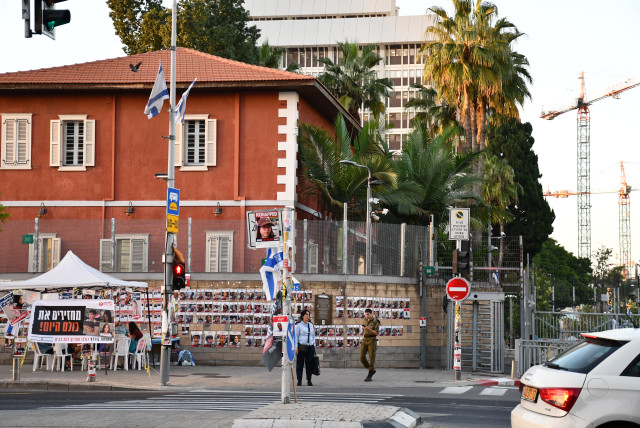A month of war: A Journey across a traumatized landscape - Reporter's Notebook

The trauma across Israel is difficult to describe.
It has been a month since the October 7 massacre.
The weeks came and went in a blur. Israel launched its ground offensive and surrounded Gaza City. Yet no matter the progress of war on the front lines, the landscape of Israel remains forever changed.
In the past month, during which I have spent time on the Gaza border, in northern Israel, in Jerusalem, and in Tel Aviv, I was also in the sun-drenched fields near Gaza, in the communities destroyed and in those evacuated.
The trauma across Israel is difficult to describe. The most noticeable difference is not the sight of funerals or similar gatherings; rather, in many cases, it is the absence of people.
Streets are quiet. Drivers don’t use their horns the way they used to. Parking lots in Tel Aviv near the beach are deserted. The city’s HaYarkon park, usually full of activities, feels abandoned, as if it has returned to nature. The beaches are almost empty. Bars and restaurants have lost their usual clamor.
Posters for the hostages are everywhere. Outside Tel Aviv’s Habima Theater, a display of empty beds has been left outside, symbolizing the empty beds of the hostages. Some people adorn their bags and bikes with yellow ribbons. People walk quietly among the posters, like ghosts.
At Tel Aviv’s Azrieli Center, the giant flashing billboard that usually displays ads for chocolate or fashion accessories now shows the kidnapped children and adults held in Gaza. A construction site is adorned with a poster of a giant lion emblazoned with the Israeli flag.
There is a juxtaposition here of mourning, demands for the return of the hostages, and patriotism, and they do not necessarily go hand-in-hand. People have been flocking to support our soldiers. The whole country seems to be either under arms or in support of the war effort.
On the other hand, it is also quiet and somber; there is no cheering for this war. There is hope that the soldiers will return, but not yet a sense of victory.
Evacuees from the South and North
In both the South and the North, communities have been evacuated – around 100 border communities and two cities – totaling at least 200,000 people who have left their homes; some because their communities were destroyed by Hamas, and any others because they were provided a place to go and encouraged to leave. They have moved to hundreds of guest houses and hotels across Israel.
Eilat is swelled by an additional 60,000 people. This means that the closer one gets to the borders, the more empty they appear. People still work the fields, thanks to volunteers who have come to help the communities.
The locals have been replaced by the army, as tanks replace tractors, APCs replace SUVs, and Humvees replace cars. And all manner of this menagerie of vehicles is on the roads; from fuel trucks to Humvees that are decades old to the ancient M113 APCs that date from the Vietnam era. These vehicles seem more fitting for a movie set as they drive around fields like armadillos plodding along.
And the army keeps moving. At Urim Junction, where several weeks ago the air was filled with the smell of meat being grilled for soldiers, the soldiers have moved on, like a nomadic tribe that has picked up their tents and migrated.
IN WAR, everything is temporary. A bivouac here, a few tanks there, some training to be done in this field and then in that field. And they leave things behind. A tank that was unloaded in the early days of the war near Yad Mordechai left tracks on the road. Tanks aren’t supposed to drive on civilian roads because they chew up the concrete. But war is war, and roads must suffer. Fields must also suffer; it isn’t melon season near the Gaza border this time, so the tanks have had the good luck of not churning up fields full of crops. Instead, perhaps, they have helped prepare the soil for the next planting.
The sounds of war are changing as well. A month into it, the rocket attacks from Gaza appear to be reduced. Some 10,000 have been fired, but half of those were fired in the first days. Today, the enemy can fire a barrage a day from Gaza. But there are other threats – from Hezbollah and other Iran-backed groups in Syria and Yemen.
The landscape is not the same. In the South, many communities now have security checks at their entrances. The security threat seems to be ever-present. In the North, they have had to add shelters to places because some communities don’t have enough. Tel Aviv is full of posters of the missing hostages. Jerusalem is quiet, but somewhat lacks the posters that are so common in Tel Aviv. Perhaps this is a reminder that behind the unity and calls for victory, the cities and towns are not all the same. The country is unified for now. But the differences are here beneath the surface.
Jerusalem Post Store
`; document.getElementById("linkPremium").innerHTML = cont; var divWithLink = document.getElementById("premium-link"); if (divWithLink !== null && divWithLink !== 'undefined') { divWithLink.style.border = "solid 1px #cb0f3e"; divWithLink.style.textAlign = "center"; divWithLink.style.marginBottom = "15px"; divWithLink.style.marginTop = "15px"; divWithLink.style.width = "100%"; divWithLink.style.backgroundColor = "#122952"; divWithLink.style.color = "#ffffff"; divWithLink.style.lineHeight = "1.5"; } } (function (v, i) { });

